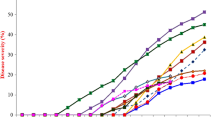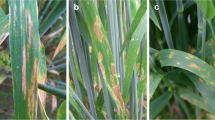Abstract
Leaf wetness duration (LWD) plays a key role in disease development and is often used as an input in disease-warning systems. LWD is often estimated using mathematical models, since measurement by sensors is rarely available and/or reliable. A strawberry disease-warning system called “Strawberry Advisory System” (SAS) is used by growers in Florida, USA, in deciding when to spray their strawberry fields to control anthracnose and Botrytis fruit rot. Currently, SAS is implemented at six locations, where reliable LWD sensors are deployed. A robust LWD model would facilitate SAS expansion from Florida to other regions where reliable LW sensors are not available. The objective of this study was to evaluate the use of mathematical models to estimate LWD and time of spray recommendations in comparison to on site LWD measurements. Specific objectives were to (i) compare model estimated and observed LWD and resulting differences in timing and number of fungicide spray recommendations, (ii) evaluate the effects of weather station sensors precision on LWD models performance, and (iii) compare LWD models performance across four states in the USA. The LWD models evaluated were the classification and regression tree (CART), dew point depression (DPD), number of hours with relative humidity equal or greater than 90 % (NHRH ≥90 %), and Penman-Monteith (P-M). P-M model was expected to have the lowest errors, since it is a physically based and thus portable model. Indeed, the P-M model estimated LWD most accurately (MAE <2 h) at a weather station with high precision sensors but was the least accurate when lower precision sensors of relative humidity and estimated net radiation (based on solar radiation and temperature) were used (MAE = 3.7 h). The CART model was the most robust for estimating LWD and for advising growers on fungicide-spray timing for anthracnose and Botrytis fruit rot control and is therefore the model we recommend for expanding the strawberry disease warning beyond Florida, to other locations where weather stations may be deployed with lower precision sensors, and net radiation observations are not available.





Similar content being viewed by others
References
Bonferroni CE (1936) Teoria statistica delle classi e calcolo delle prob-abilità. Istituto Superiore di Scienze Economiche e Commerciali di Firenze, Florence, Publ. 8. R
Bulger M, Ellis M, Madden L (1987) Influence of temperature and wetness duration on infection of strawberry flowers by Botrytis cinerea and disease incidence of fruit originating from infected flowers. Phytopathology 77:1225–1230
Dietterich TG (2000) An experimental comparison of three methods for constructing ensembles of decision trees: bagging, boosting, and randomization. Mach Learn 40:139–157
Duttweiler KB, Gleason ML, Dixon PM et al (2008) Adaptation of an apple sooty blotch and flyspeck warning system for the upper midwest United States. Plant Dis 92:1215–1222
Gauch HG, Hwang JTG, Fick GW (2003) Model evaluation by comparison of model-based predictions and measured values. Agron J 95:1442–1446
Gillespie TJ, Sentelhas PC (2008) Agrometeorology and plant disease management: a happy marriage. Sci Agric 65:71–75
Gillespie TJ, Srivastava B, Pitblado RE (1993) Using operational weather data to schedule fungicide sprays on tomatoes in southern Ontario, Canada. J Appl Meteorol 32:567–573
Gleason ML (2007) Validation of weather inputs for disease warning systems. Phytopathology 97:S147
Gleason ML, Taylor SE, Loughin TM, Koehler KJ (1994) Development and validation of an empirical model to estimate the duration of dew periods. Plant Dis 78:1011–1016
Gleason ML, Duttweiler KB, Batzer JC et al (2008) Obtaining weather data for input to crop disease-warning systems: leaf wetness duration as a case study. Sci Agric 65:76–87
Huber L, Gillespie TJ (1992) Modeling leaf wetness in relation to plant disease epidemiology. Annu Rev Phytopathol 30:553–577
Iziomon MG, Mayer H, Matzarakis A (2000) Empirical models for estimating net radiative flux: a case study for three mid-latitude sites with orographic variability. Astrophys Space Sci 273:313–330
Kim KS, Taylor SE, Gleason ML (2004) Development and validation of a leaf wetness duration model using a fuzzy logic system. Agric For Meteorol 127:53–64
Legard DE, MacKenzie SJ, Mertely JC et al (2005) Development of a reduced use fungicide program for control of Botrytis fruit rot on annual winter strawberry. Plant Dis 89:1353–1358
Lulu J, Sentelhas P, Pedro M et al (2008) Estimating leaf wetness duration over turfgrass, and in a “Niagara Rosada” vineyard, in a subtropical environment. Sci Agric 65:10–17
MacKenzie SJ, Peres NA (2012a) Use of leaf wetness and temperature to time fungicide applications to control anthracnose fruit rot of strawberry in Florida. Plant Dis 96:522–528
MacKenzie SJ, Peres NA (2012b) Use of leaf wetness and temperature to time fungicide applications to control Botrytis fruit rot of strawberry in Florida. Plant Dis 96:529–536
Monteith JL (1990) Principles of environmental physics, 2nd edn. Edward Arnold, London
Pavan W, Fraisse CW, Peres NA (2011) Development of a web-based disease forecasting system for strawberries. Comput Electron Agr 75:169–175
Rao PS, Gillespie TJ, Schaafsma AW (1998) Estimating wetness duration on maize ears from meteorological observations. Can J Soil Sci 78:149–154
Rowlandson T, Gleason M, Sentelhas P et al (2015) Reconsidering leaf wetness duration determination for plant disease management. Plant Dis 99:310–319
Sentelhas P, Gillespie T, Gleason M et al (2004a) Operational exposure of leaf wetness sensors. Agric For Meteorol 126:59–72
Sentelhas PC, Monteiro JEBA, Gillespie TJ (2004b) Electronic leaf wetness duration sensor: why it should be painted. Int J Biometeorol 48:202–205
Sentelhas PC, Gillespie TJ, Gleason ML et al (2006) Evaluation of a Penman-Monteith approach to provide “reference” and crop canopy leaf wetness duration estimates. Agric For Meteorol 141:105–117
Sentelhas PC, Dalla Marta A, Orlandini S et al (2008) Suitability of relative humidity as an estimator of leaf wetness duration. Agric For Meteorol 148:392–400
USDA (2013) U.S. strawberry production, utilization, prices, and values, 1970-2012. http://usda.mannlib.cornell.edu/MannUsda/viewDocumentInfo.do?documentID=1381. Accessed 27 Jan 2014
USDA (2013) U.S. strawberry harvested acreage, yield per acre, and production, 13 States, 1970-2012. http://usda.mannlib.cornell.edu/MannUsda/viewDocumentInfo.do?documentID=1381. Accessed 17 July 2013
Wilson L, Madden L, Ellis M (1990) Influence of temperature and wetness duration on infection of immature and mature strawberry fruit by Colletotrichum acutatum. Phytopathology 80:111–116
Acknowledgments
This research was supported by a US Department of Agriculture/National Institute of Food and Agriculture funding under project No. 2010-51181-21113.
Author information
Authors and Affiliations
Corresponding authors
Rights and permissions
About this article
Cite this article
Montone, V.O., Fraisse, C.W., Peres, N.A. et al. Evaluation of leaf wetness duration models for operational use in strawberry disease-warning systems in four US states. Int J Biometeorol 60, 1761–1774 (2016). https://doi.org/10.1007/s00484-016-1165-4
Received:
Revised:
Accepted:
Published:
Issue Date:
DOI: https://doi.org/10.1007/s00484-016-1165-4




